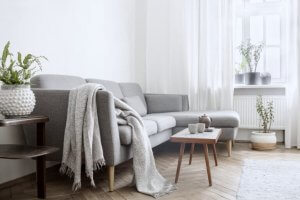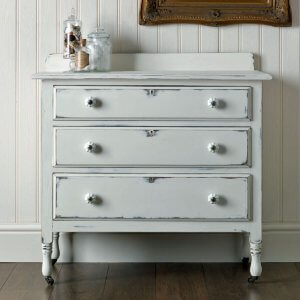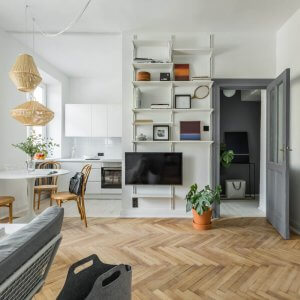Ways You Can Transform Small Spaces

If you’re one of those people who think you need to have a large house to carry out a fantastic interior design project, then this article is for you. You don’t need a big house to recreate the style or aesthetics you like. Small spaces will do just fine, and they’re also one of the most exciting decoration challenges.
In interior design, there are many ways we have ways to use small areas so that the lack of space isn’t noticeable. One of the ways to evade the shortage of space is by signing up for the maxim of ‘less is more’.
It’s about finding a way to add layers in rooms with various types of furniture. For example, using ottomans and stacked shelves not only create more space but bring elegance and character to a room.
Within small spaces, using custom pieces is another way to go. You only have to slide some pieces a little below others to gain a few centimeters.
The use of the appropriate colors and accents touches will give a professional finish in whichever room you decorate, regardless of its size.
Vintage furniture for small spaces

A surprising resource that is often ruled out first when decorating small spaces is vintage furniture. This type of furniture is usually smaller in scale than most modern furniture and so works in a small room.
Antique sofas are a few inches shallower than today’s standard sizes. You can have the same number of seats but save considerable space.
Another key point is that the largest piece of furniture in the room should be in neutral tones and without patterns. This avoids creating the illusion of the furniture being larger than it already is.
Floors and ceilings

The floors of small rooms should appear uniform, without lines dividing the space. For example, if you are thinking of installing carpet, make sure it completely covers the floor (wall to wall).
If you’re not able to do this, try to at least make sure that the carpet is in neutral tones and doesn’t have too many geometric patterns. If you have a nice wooden floor, don’t put rugs on it. This can make the room look smaller.
You can apply more visual tricks to make the room appear bigger than it is.
A good way to do this is to raise the curtain rod to the ceiling. This makes the windows it covers appear larger and taller.
The same effect can be created by hanging pictures correctly. In small spaces, paintings and works of art should be hung vertically on top of each other on the walls and carried to the top. This way, you’ll have more visual space to look at. This also makes the room seem bigger than it is.
Useless corners in small spaces

Small spaces often have difficult corners that are hard to put to use. These are the perfect elements to create a focal point.
Painting a corner in a tone that gives it a dramatic touch and placing a sculpture, vase, or shelf that contrasts with the wall creates an immediate focal point and makes the room stand out.
Open and aesthetic storage

Oddly enough, large book collections are very useful for decorating small spaces. The trick is to set up tall, open shelves and color-code the books. This adds a surprising color and uniform effect to the room.
You can do the same with perfume, jewelry, and accessories. You can organize them in trays and place them on view, to act as decorative accessories. If you do this in moderation, this can substitute artwork that is too big to be displayed.
Give different uses to small spaces

If you have to decide between setting up a breakfast table or a work table, think about which one you use more often and get rid of the other one. In other words, if you don’t usually eat breakfast at home, you can turn that space into a nice work area.
Like large spaces, small rooms only require a few objects or pictures to disguise the lack of space. They also add some surprise elements that divert attention away from the size of the room.
If you’re one of those people who think you need to have a large house to carry out a fantastic interior design project, then this article is for you. You don’t need a big house to recreate the style or aesthetics you like. Small spaces will do just fine, and they’re also one of the most exciting decoration challenges.
In interior design, there are many ways we have ways to use small areas so that the lack of space isn’t noticeable. One of the ways to evade the shortage of space is by signing up for the maxim of ‘less is more’.
It’s about finding a way to add layers in rooms with various types of furniture. For example, using ottomans and stacked shelves not only create more space but bring elegance and character to a room.
Within small spaces, using custom pieces is another way to go. You only have to slide some pieces a little below others to gain a few centimeters.
The use of the appropriate colors and accents touches will give a professional finish in whichever room you decorate, regardless of its size.
Vintage furniture for small spaces

A surprising resource that is often ruled out first when decorating small spaces is vintage furniture. This type of furniture is usually smaller in scale than most modern furniture and so works in a small room.
Antique sofas are a few inches shallower than today’s standard sizes. You can have the same number of seats but save considerable space.
Another key point is that the largest piece of furniture in the room should be in neutral tones and without patterns. This avoids creating the illusion of the furniture being larger than it already is.
Floors and ceilings

The floors of small rooms should appear uniform, without lines dividing the space. For example, if you are thinking of installing carpet, make sure it completely covers the floor (wall to wall).
If you’re not able to do this, try to at least make sure that the carpet is in neutral tones and doesn’t have too many geometric patterns. If you have a nice wooden floor, don’t put rugs on it. This can make the room look smaller.
You can apply more visual tricks to make the room appear bigger than it is.
A good way to do this is to raise the curtain rod to the ceiling. This makes the windows it covers appear larger and taller.
The same effect can be created by hanging pictures correctly. In small spaces, paintings and works of art should be hung vertically on top of each other on the walls and carried to the top. This way, you’ll have more visual space to look at. This also makes the room seem bigger than it is.
Useless corners in small spaces

Small spaces often have difficult corners that are hard to put to use. These are the perfect elements to create a focal point.
Painting a corner in a tone that gives it a dramatic touch and placing a sculpture, vase, or shelf that contrasts with the wall creates an immediate focal point and makes the room stand out.
Open and aesthetic storage

Oddly enough, large book collections are very useful for decorating small spaces. The trick is to set up tall, open shelves and color-code the books. This adds a surprising color and uniform effect to the room.
You can do the same with perfume, jewelry, and accessories. You can organize them in trays and place them on view, to act as decorative accessories. If you do this in moderation, this can substitute artwork that is too big to be displayed.
Give different uses to small spaces

If you have to decide between setting up a breakfast table or a work table, think about which one you use more often and get rid of the other one. In other words, if you don’t usually eat breakfast at home, you can turn that space into a nice work area.
Like large spaces, small rooms only require a few objects or pictures to disguise the lack of space. They also add some surprise elements that divert attention away from the size of the room.







